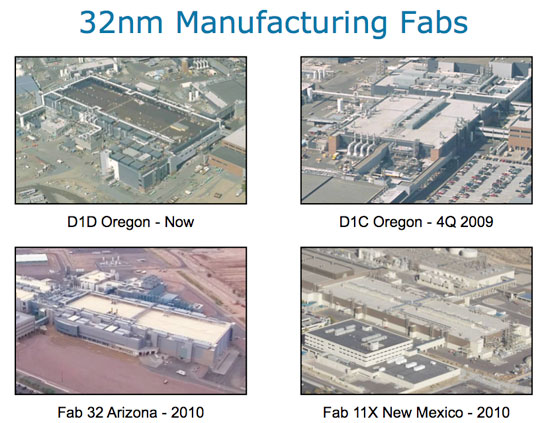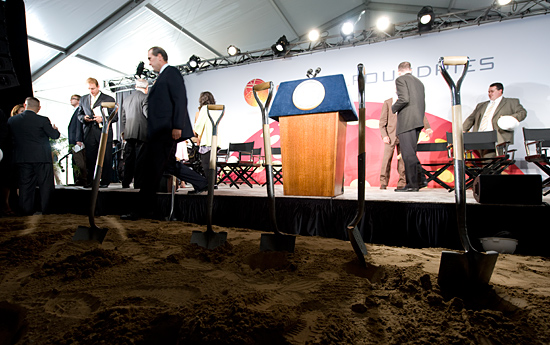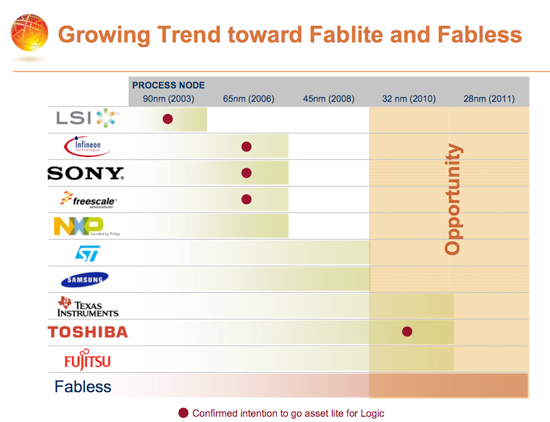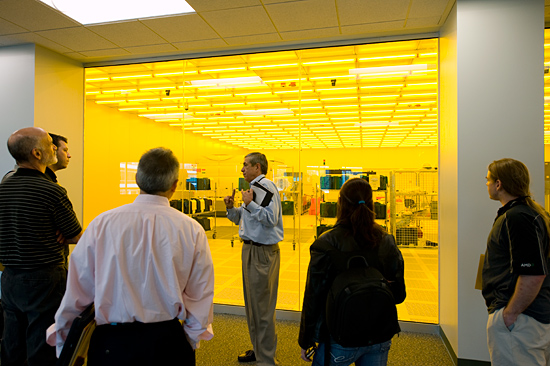Globalfoundries Starts on 22nm Fab & Announces First non-AMD Customer
by Anand Lal Shimpi on July 29, 2009 4:01 AM EST- Posted in
- CPUs
Somehow I’d managed to dodge meeting with Globalfoundries since the company was formed earlier this year. For those of you who don’t know, AMD is now officially a fabless semiconductor. AMD provided its two existing fabs to the new company and its partner, ATIC (Advanced Technology Investment Company) provided $6B. ATIC owns 65.8% of the new company and AMD owns the rest, although the two share voting rights.
AMD’s biggest limitation has always been capital. Intel currently has four fabs that will be producing 32nm chips by the end of 2010, AMD currently has (err, had) a single 45nm fab in Dresden. There’s simply no way AMD could compete in the fab game with Intel, so it chose to partner up with ATIC, take $6B of their dollars, and spin off its fab business.

Intel's 32nm fabs for 2010
Until this morning, Globalfoundries only had a single customer - AMD, but that just changed with the announcement that STMicro would be using their fabs. Currently Globalfoundries only has AMD’s two fabs in Dresden, Germany, only one of which is producing modern 45nm SOI wafers. But that too is about to change.

Ceremonial shovels, at a ceremonial ground breaking
My first official meeting with GF came just this past week, in Saratoga County, NY. That’s the site where its brand new post-AMD fab will be constructed and it’s sort of a big deal. I was there for the ceremonial ground breaking, but concrete doesn’t get poured until September, the shell won’t be finished until 2010 and the fab won’t be done until 2011. Globalfoundries won’t be able to ship revenue generating wafers until 2012. But that’s ok, with $6B in the bank and a strong commitment from wealthy ATIC the company couldn’t be in a better place.

On Competing with TSMC
AMD couldn’t last competing in the foundry game with Intel. The chart below just shows how expensive it gets:

At 32nm a single fab can cost $4B and in just two years it’ll need to be upgraded (to the tune of around a billion) to support 22nm production. For AMD to support the costs alone and remain competitive with Intel, it would have to virtually own the x86 microprocessor market. Even when AMD held the technology crown, that didn’t happen.
The other alternative is to subsidize the cost of these expensive factories over multiple customers. This is where things get interesting. AMD alone may not be able to fill a fab and make the investment pay off, but AMD + Sony + Toshiba + NVIDIA + etc... can definitely make it work.

Globalfoundries' potential customers and when they plan on going fabless
Currently, fabless semiconductor manufacturers like NVIDIA (and the graphics division of AMD) go to foundry companies like TSMC for their manufacturing needs. In return, they get nearly the latest manufacturing processes (TSMC is at 55nm for volume and 40nm while Intel is at 45nm moving to 32nm) and don’t have to worry about building expensive fabs.
There are problems with this approach. For starters, TSMC has been having troubles moving to 40nm - as you may have heard. Just as important, you don’t get the most advanced manufacturing process technically available. There’s also the fact that TSMC has very little real competition in the industry; all of the GPUs you’re used to reading about are made at TSMC.

The machine to the left of the man's head in the center of the pic is a 193nm lithography machine. We weren't allowed to take close photos, but that machine costs around $75M. Fabs are expensive.
Companies like Sony, Freescale, Samsung, Toshiba and TI all currently fab their own chips. These chips are far less complex than a Nehalem or a Radeon HD 4890 and are thus made on 130nm, 90nm or 65nm processes. The SoC (System on Chip) in the iPhone 3GS is built on a 65nm process by Samsung at its own fab. Being able to move to 45nm or 32nm alongside Intel would give Apple, Samsung and even ARM in general a tremendous competitive boost in the market place. A 45nm iPhone 3GS would use less power or even run at higher clock speeds.
The need for a modern fab partner increases as you look at Intel’s motions towards competing in the smartphone space. Once Atom finally makes its way into smartphones, Intel could have a manufacturing advantage over the ARM partners - allowing for quicker scaling to lower power and higher performance designs. In other words, companies making smartphone SoCs need a good foundry option to compete with Intel.










50 Comments
View All Comments
TA152H - Thursday, July 30, 2009 - link
Obviously, you're a moron.Think before you post, OK?
IBM CAN afford just about anything, but they don't afford things that lose money. Perforce, IBM's fabs make money, or they'd jettison them. How is it they make money with their fabs, and AMD can't? AMD sells a lot more processors. The answer is simple, except for you. AMD is making a crappy processor they can't sell for much money.
I'll say it again, because you're obviously slow. IBM has fabs that make money, or they'd get out of the business. They sell less processors. Therefore, AMD having to own the x86 business is a idiotic remark. They just need processors that they can sell for a higher margin. Got it now, simpleton?
HVAC - Wednesday, July 29, 2009 - link
Dear Brybir,Here, let me help you by writing the reply you should have written instead of the diatribe you did submit:
"@TA152H .... MORON!"
brybir - Wednesday, July 29, 2009 - link
You are correct.I got caught in a moment of weakness in my desire to keep the trolls away. I am also bored at work. A very bad combination.
What I have done here represents all that is bad and wrong with the world. I will turn in my nerd card at the door and go sit in a shallow pool of cold water in a dark corner of the room until I am better.
DFranch - Wednesday, July 29, 2009 - link
strikeback03: I did not realize that Malta, NY had a reputation for rain. It's not exactly Seattle.strikeback03 - Wednesday, July 29, 2009 - link
I lived in the area for 4 years, it rains enough, and snows morekarhill - Wednesday, July 29, 2009 - link
Malta's annual rainfall is about 43.5 inches, compared to 37 inches for Seattle.Tuor - Thursday, July 30, 2009 - link
Heh. You shouldn't be looking at rain totals, but days per year that it's mostly cloudy/cloudy. I'm pretty sure Seattle will beat out Malta pretty easily in that regard... but maybe not.JarredWalton - Thursday, July 30, 2009 - link
http://countrystudies.us/united-states/weather/was...">Olympia is much worse than http://countrystudies.us/united-states/weather/was...">Seattle, according to that site.JarredWalton - Wednesday, July 29, 2009 - link
Ha! You leave my lovely state of WA out of this. At least here in Olympia, we get very little (if any) rain during the time of June-August. My grass is dead, and current temps are in the mid-90s (supposed to hit 101F today!), which totally sucks. Anything above 80F is too hot for me. :-(GIVE ME BACK MY RAIN, DAGNABBIT!
FYI, Olympia gets more rain than Seattle: estimate is around 180 days of rain per year. LOL
just4U - Thursday, July 30, 2009 - link
Yeah it's really hot here in Calgary, Canada right now. It's like 61F .. and were expecting it to get up to 82F tomorrow.. Ugh!!(WTH who thru that shoe at me! oO)